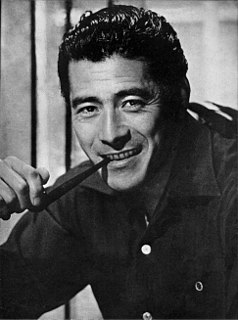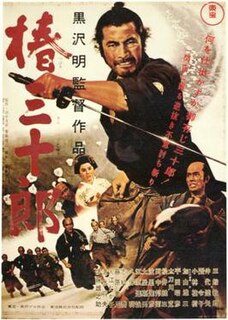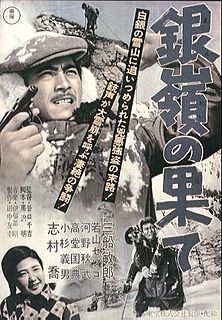Related Research Articles

Akira Kurosawa was a Japanese film director and screenwriter, who directed 30 films in a career spanning 57 years. He is regarded as one of the most important and influential filmmakers in the history of cinema.

Toshiro Mifune was a Japanese actor who appeared in over 150 feature films. He is best known for his 16-film collaboration (1948–65) with Akira Kurosawa in such works as Rashomon, Seven Samurai, The Hidden Fortress, Throne of Blood, and Yojimbo. He also portrayed Miyamoto Musashi in Hiroshi Inagaki's Samurai Trilogy and one earlier Inagaki film, Lord Toranaga in the NBC television miniseries Shōgun, and Admiral Isoroku Yamamoto in three different films.

Sanjuro is a 1962 black-and-white Japanese jidaigeki film directed by Akira Kurosawa and starring Toshiro Mifune. It is a sequel to Kurosawa's 1961 Yojimbo.

Yojimbo is a 1961 Japanese samurai film directed by Akira Kurosawa. It tells the story of a rōnin, portrayed by Toshiro Mifune, who arrives in a small town where competing crime lords vie for supremacy. The two bosses each try to hire the newcomer as a bodyguard.

Ishirō Honda, sometimes miscredited in foreign releases as "Inoshiro Honda", was a Japanese film director and screenwriter. He is best known for his kaiju and tokusatsu films, including several entries in the Godzilla franchise, but also worked extensively in the documentary and war genres earlier in his career. Honda was also a lifelong friend and collaborator of Akira Kurosawa, and worked with Kurosawa extensively during the 1980s and 1990s.

Stray Dog is a 1949 Japanese crime drama film noir directed by Akira Kurosawa and starring Toshiro Mifune and Takashi Shimura. It was Kurosawa's second film of 1949 produced by Film Art Association and released by Shintoho. It is also received as a detective movie that explores the mood of Japan during its painful postwar recovery. The film is considered a precursor to the contemporary police procedural and buddy cop film genres.

Drunken Angel is a 1948 Japanese yakuza film directed by Akira Kurosawa. It is notable for being the first of sixteen film collaborations between director Kurosawa and actor Toshiro Mifune.
Shinobu Hashimoto was a Japanese screenwriter, film director and producer. A frequent collaborator of Akira Kurosawa, he wrote the scripts for such internationally acclaimed films as Rashomon and Seven Samurai.

Fumio Hayasaka was a Japanese composer of classical music and film scores.

Senkichi Taniguchi was a Japanese film director and screenwriter.

Snow Trail is a 1947 black-and-white Japanese film directed by Senkichi Taniguchi from Akira Kurosawa's screenplay. It was the first film role for Toshirō Mifune, later to become one of Japan's most famous actors. Mifune and the other main actor in the film, Takashi Shimura, later became long-term collaborators of film director Akira Kurosawa.
Stuart Eugene Galbraith IV is an American film historian, film critic, essayist, and audio commentator.

Tora-san Goes NorthakaTorasan, Remind Shiretoke is a 1987 Japanese comedy film directed by Yoji Yamada. It stars Kiyoshi Atsumi as Torajirō Kuruma (Tora-san), Keiko Takeshita as the film's "Madonna", and Toshiro Mifune as Takeshita's father. Tora-san Goes North is the thirty-eighth entry in the popular, long-running Otoko wa Tsurai yo series.
A number of Akira Kurosawa's films have been remade.

Kajirō Yamamoto was a Japanese film director, screenwriter, and actor who was known for his war films and comedies and as the mentor of Akira Kurosawa. The combined list of his efforts as a director for documentaries, silent, and sound films includes over 90 film titles during his lifetime.

Something Like an Autobiography is the memoir of Japanese film director Akira Kurosawa. It was published as a book in 1981 and the English translation by Audie E. Bock appeared the following year.
Ryuzo Kikushima was a Japanese writer and film producer who is best known for co-writing the screenplays for several Akira Kurosawa films, including Throne of Blood, The Hidden Fortress, Yojimbo and High and Low. He also produced several of Kurosawa's early 1960s films. In addition to his work with Kurosawa, screenplays he wrote or co-wrote include Tora! Tora! Tora!, Hiroshi Inagaki's Arashi and The Birth of Japan, and Mikio Naruse's When a Woman Ascends the Stairs, on which he also served as producer.
Sōjirō Motoki was a Japanese filmmaker who served primarily as a film producer, but also as a writer and director. He was most famous for producing several films for Akira Kurosawa, including Seven Samurai, Ikiru and Throne of Blood. He also produced films for other directors, including Mikio Naruse, for whom he produced Spring Awakens and Battle of Roses, and Kazuo Mori, for whom he produced Vendetta for a Samurai. As a writer, he provided the story for Kei Kumai's 1968 film The Sands of Kurobe, starring Kurosawa favorite Toshiro Mifune.
The legacy of filmmaking technique left by Akira Kurosawa for subsequent generations of filmmakers has been diverse and of international influence. The legacy of influence has ranged from working methods, influence on style, and selection and adaptation of themes in cinema. Kurosawa's working method was oriented toward extensive involvement with numerous aspects of film production. He was also an effective screenwriter who would work in close contact with his writers very early in the production cycle to ensure high quality in the scripts which would be used for his films.
References
- Notes
- ↑ Oguni and AK based this script on an unproduced screenplay they had written near the end of World War II.
- ↑ Remake of the 1950 film of the same name.
- ↑ Remake of the 1949 film of the same name.
- ↑ Remake of Kurosawa's own films, Sanshiro Sugata and Sanshiro Sugata Part II.
- ↑ AK was hired as director of the Japanese sequences of this film, but left the project; his name was taken off the credits at his request, but the screenplay he co-wrote was still used.
- ↑ AK was originally slated to direct this project in 1966-67 but dropped out; neither Oguni nor Kikushima were credited in the final film.
- ↑ Originally conceived as a project for AK to direct; filmed after his death by Koizumi.
- ↑ These three directors and AK wrote this script, allegedly for all four to direct together, around the time of Dodesukaden (1970), but due to the box-office failure of that film, the project was canceled; it was finally directed by the last surviving member of the club, Ichikawa.
- ↑ Originally conceived as a project for AK to direct; filmed after his death by Kumai.
- ↑ Mifune, directing his first film, was not confident of this suspense thriller's reception, so he hired Kurosawa to travel to the location and re-edit the footage. The latter agreed to do this more as a favor to his favorite actor than because of any belief in the project. The picture was a modest box-office success, but a critical disaster, and Mifune never directed another film.
- References
- ↑ Jason Gray (2008-03-03). "Unfinished Kurosawa Film to be Unveiled in 2010" . Retrieved 2010-08-24.
- 1 2 "Other Movies with Kurosawa's Involvement — Akira Kurosawa Information" . Retrieved 2010-08-23.
- ↑ Galbraith , pp. 651–751
- ↑ Akira Kurosawa on IMDb
- ↑ Galbraith , pp. 448–471
- ↑ Galbraith , pp. 441–448
- ↑ Galbraith , p. 646
- ↑ Galbraith , p. 30
- ↑ Galbraith , pp. 364–370, 703
- ↑ Nogami , pp. 246–247
- ↑ Kurosawa 1982 , p. 144
- ↑ Galbraith , p. 63
- ↑ Seven Samurai , DVD featurette: My Life in Cinema (Waga Eiga Jinsei): Interview of Akira Kurosawa by Nagisa Oshima)
- 1 2 Galbraith , p. 98
- ↑ Drunken Angel , DVD featurette "It Is Wonderful to Create"
- ↑ Galbraith , pp. 486–487
- ↑ Kurosawa 1982 , pp. 172–173
- ↑ Galbraith , p. 109
- ↑ Kurosawa 1982 , p. vi
- ↑ Galbraith , p. 561
- ↑ Kurosawa 1999 , Chapter 3, found at: http://ww.criterionforum.org/forum/viewtopic.php?f=25&t=7192 ; translation: Noriyo Hoozawa-Arkenau
- Sources
- Drunken Angel(DVD)
|format=requires|url=(help). Criterion. - Galbraith IV, Stuart (2002). The Emperor and the Wolf: The Lives and Films of Akira Kurosawa and Toshiro Mifune. New York-London: Faber and Faber, Inc. ISBN 0-571-19982-8.
- Kurosawa, Akira (1982). Something Like an Autobiography. Translated by Audie E. Bock. New York: Alfred A. Knopf. ISBN 0-394-50938-2.
- Kurosawa, Akira (1999). Yume wa tensai de aru (A Dream Is a Genius). Tokyo: Bungei Shunjū. ISBN 4-16-355570-6.
- Nogami, Teruyo (2006). Waiting on the Weather. Berkeley: Stone Bridge Press. ISBN 978-1-933330-09-9.
- Seven Samurai: 3-disc Remastered Edition (Criterion Collection Spine #2)(DVD)
|format=requires|url=(help). Criterion.